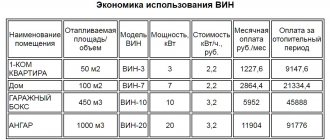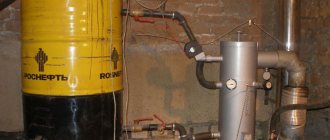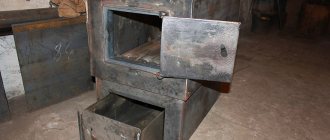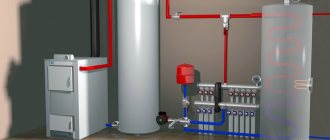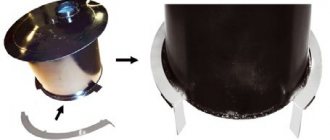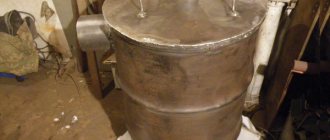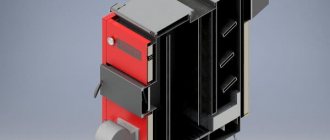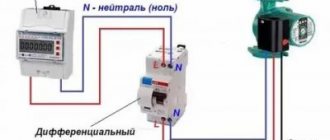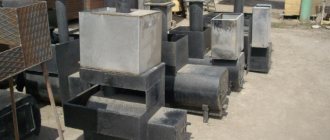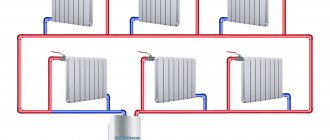The concept of electromagnetic induction was discovered back in 1831, and was later widely used in factory equipment.
Now they have learned to use it for heating private houses. The industry has recently produced a large number of boilers operating on this principle.
Since buying an induction heating boiler is not affordable for everyone, you can try making an induction heating boiler with your own hands. To do this, it is important to understand the structure and intricacies of this unit.
Principle of operation
As you know, metal located in a magnetic field heats up. And if this piece of iron is placed in a water heating circuit, then the coolant circulating through the pipes will take the temperature from it.
Operating principle of the SAV induction boiler
An induction boiler heats up the room faster, but this does not mean that it is more economical than its heater counterpart. Their efficiency is the same.
DIY electric induction heating boiler
By making an induction boiler yourself, you can save a significant amount, so it's worth a try. Here's what we need:
- Thick-walled polypropylene pipe with an internal diameter of 50 mm.
- Two couplings of the same diameter and two adapters from 50 mm to the diameter of the existing heating system.
- Soldering iron for welding polypropylene.
- Steel or nylon fine mesh.
- Stainless steel wire with a diameter of 7 mm.
- An inverter from the cheapest welding machine with a welding current of 15 A or higher and the ability to continuously regulate it.
- Copper enameled wire with a cross section of 2 square meters. mm (1 sq. mm for every 8 A of current).
Next we proceed as follows:
- Carefully cut out two circles from the mesh with a diameter corresponding to the outer diameter of the plastic pipe.
- The pipe and coupling must be heated on a soldering iron. Then you need to quickly lay a circle of mesh on the end of the pipe, and then put on the coupling.
- Having turned the polypropylene pipe vertically with the mesh down, it must be filled with pieces of stainless wire 40 - 50 mm long.
- When the pipe is filled, a second coupling with a mesh must be installed on its free end. Both meshes are needed to hold the wire inside the “boiler”.
- Using a soldering iron, we also install adapters into the couplings to the diameter we need.
- All that remains is to wind 90 turns of enameled copper wire onto the pipe and connect the resulting coil to the inverter.
After connecting the device to the network, the wire inside will begin to heat up, and with it the coolant.
Advantages and disadvantages
The advantages of induction heating include the following facts:
- No scale is formed.
- There is no burning, no soot, no storage space required.
- No chimney needed.
- Long service life without loss of characteristics.
- The device has a modest size despite its considerable power.
- Heats up the coolant faster than other electric analogues.
Even though scale does not form on the boiler parts, it is still recommended to go through it every two years to inspect and carry out maintenance.
Minuses:
- Electricity bills will be considerable.
- The cost of the boiler itself is more than that of a heating element (although a homemade one will be cheaper).
- Controversial environmental friendliness.
A person using electricity for heating may think that he is not harming the atmosphere. But in order to generate electricity, it was necessary to burn coal somewhere far away in a power plant, build a dam, or split an atom.
Comparison of induction boiler with heating element boilers
Both types of devices are converters of electrical energy into heat. The efficiency in both types of devices is the same - almost 100%, so in this regard they are equivalent .
Induction boilers are much more expensive, but practice has shown that over 5 - 7 years of operation due to maintenance (replacement of burnt-out heating elements) of the heating element boiler, their cost equalizes. The heating rate of the same volume of coolant by boilers of these types of electrical energy-to-heat converters of equal power consumption is also the same .
An induction boiler has many operational advantages because it has a much larger area of heat transfer to the coolant than in a heating element boiler.
Main differences:
- The difference between the temperature of the heating element of the induction boiler and T* of the coolant is 10 - 15* C and they heat up together. There is practically no scale formation on the heating element of an induction boiler . For this reason, its heating element cannot even theoretically fail.
- The heating element heats up because current flows through its conductor with increased resistance, so in any case it heats up to the specified 600 - 750 * C and the coolant on its surface always boils. Because of this, the heating element quickly becomes overgrown with scale . As a result, heat transfer decreases, and the heating element eventually burns out.
- In an induction boiler, you can use different coolants , even petroleum products, if they are not overheated above 70* C.
- In heating element boilers, only water can be used as a coolant and, moreover, distilled water .
- In maintenance, heating element boilers are less practical than induction boilers, because the transition contact between the power supply conductor and the conductor of the heating element itself is constantly overheated, as a result of which it is oxidized and weakened . It is necessary to constantly ensure that the power supply conductor does not burn out; otherwise, when burned out, the threaded connection of the heating element may be damaged; and such a working heating element has to be changed. This problem does not exist in induction boilers, because the connection of its heating element with the power supply is carried out through the electromagnetic field of alternating current.
- Induction boilers can be installed in any place, even not in a separate place. They are fireproof and operate silently .
- Induction boilers provide much higher than heating element boilers, because the heating element itself can burn out in two ways: a) with depressurization of the housing ; in this case, heated nichrome crumbles when water hits it - there is no danger of a person coming under voltage; b) without depressurization of the housing ; in this case, heated nichrome may stick to the body of the heating element. The heating element continues to work, and through the water the metal body of the boiler becomes energized.
- It is not yet possible to make the induction coil of an induction boiler with powers of 3 kW or more at 50 Hz small and compact. Therefore, the heating element boiler has much smaller dimensions at the same power than an induction boiler.
Induction boiler production process
In order to make a vortex heating device, you need the following tool:
- Welding inverter (both for assembling the housing and for subsequent connection of the boiler).
- Bulgarian.
For the case you will need:
- Metal pipes of such diameters that they fit freely into each other (a gap of about a centimeter).
- Branch pipes (pipes) for installation on heating pipes.
- Wire.
Homemade induction boiler
Instructions:
- Two “glasses” are brewed, one with a larger diameter, the other with a smaller diameter. So that they enter into each other. The outer one will be the body of the device, and a coil is wound onto the inner one along the insulation layer, the ends of which are brought out through the bottom of the upper “glass”.
- The body parts can be connected either with flanges or welded tightly. The flange connection will allow you to further disassemble and reassemble the device without resorting to crude methods.
- When two parts are connected, a labyrinth is created in which the coolant is heated.
- Using connections, the resulting device is connected to the heating system. It is welded or screwed with couplings. When installing, it is important to remember that cold water will enter from below and hot water will come out from above.
- It is better to place the electrician above the boiler to avoid a short circuit in case of a leak.
Since a vortex boiler is a complex product, it is better not to undertake its manufacture if the principle of operation is not completely clear to you or you doubt that you can do everything efficiently and correctly.
Mechanism of action
The principle of operation of the boiler is based on the functioning of inductors, which consist of two short-circuited windings. First of all, electricity is supplied to the internal winding. Here it is transformed into so-called eddy currents. During this process, a fairly powerful electric field arises inside the device. Subsequently, it moves to the secondary turn.
The second turn acts as a heating element. It is also the body of the structure. From it, thermal energy is transferred to the coolant of the system. As a result, it heats up. It is worth noting that purified water, antifreeze and special oil can be used as a coolant. The advantage of the latter substance is that it can retain heat for a long time.
Operating principle of the boiler
To put it simply, the process begins with the supply of electricity to the internal winding. Under its influence, voltage appears in the circuit, and Foucault currents are also formed. The energy in the next stage is transferred to the secondary winding, resulting in heating of the core. After the surface of the coolant is completely heated, it circulates through the system and is supplied to the radiators.
The simplest induction boiler
Frame
They are made of non-conducting material; plastic pipe is most suitable for this. A winding is wound onto it, which will serve as a source of magnetic field. This housing will be part of the heating system, and coolant (antifreeze, water - it doesn’t matter) will circulate inside through the core.
Winding
It is most often made from copper wire with a cross-section of 2 squares (If this is not available, you can connect several thin ones in parallel to achieve the required cross-section).
Aluminum wire will also work, but it should be twice as thick.
It is important to ensure that there is good insulation to avoid turn-to-turn short circuits.
For reliability, the coils can be fixed with glue at a short distance from each other (5 - 10 mm - depending on the length of the pipe).
2mm2 copper wire is quite expensive. To save money, you can “get it”, for example, in a transformer, rectifier or electric motor.
Core
The core is an element heated by a magnetic field, which will transfer its temperature to the coolant. In our case, these are chopped pieces of ferrous metal wire (to react to a magnetic field).
Power converter
It powers a homemade induction boiler - a welding transformer (inverter).
Its power should be enough for the volume of the heated room (this is from 15 Amps and above).
With a power above 7 kW, a 380 Volt connection is made.
Design and principle of operation of the equipment
Before you start assembling an induction boiler yourself, you need to understand its structure and operating principle. And only after understanding these points can you start making homemade products.
How does an induction boiler work?
To understand how induction equipment works, you need to become familiar with the principle of its operation. So let’s remember the school physics course.
When electrical current passes through a conductive material, it generates heat. In this case, the amount of heat received will be directly proportional to the voltage and current. This pattern was discovered by Joule and Lenz, after whom the physical law is named.
Image gallery
Photo from
Operating principle of induction heaters and boilers
Advantages of no direct heating
Standard components of an induction boiler
Homemade induction heater option
But electric current can appear in a conductor not only when it is directly connected to a power source. There is another method, discovered in the century before last by M. Faraday. This is a non-contact method that does not involve interaction between the power source and the conductor.
Its essence lies in the fact that when the parameters of the magnetic field that crosses the conductor change, an emf or electromotive force appears in it.
This phenomenon was called electromagnetic induction. This is what is used in the operation of the induction boiler. It turns out that if there is an EMF, then there will be an electric current, and accordingly, there will be heating of the conductor.
In this case, it will be produced in a contactless manner, using induced currents or, as they are also called, Foucault currents.
Electromagnetic induction can be obtained in two ways. In the first case, to obtain induction, a conductor is rotated or moved within a constant magnetic field. This method is used in electric generators.
Another way to obtain induction is that the conductor remains stationary, while the parameters of the magnetic field in which it is located, namely the direction of the field lines and intensity, are constantly changing.
The operation of any induction boiler is based on the phenomenon of electromagnetic induction
This would have been quite difficult to do if not for Oersted’s discovery. He found out that if a wire is wound around a coil, then when a power source is connected, it turns into an electromagnet. When the direction and strength of the current changes, the magnetic field that this device generates will also change.
If a conductor is placed inside the field, an electric current will arise in it, which is accompanied by heating.
It is on this principle that an induction boiler is designed. Its design is very simple. It includes a housing, which must be thermally insulated and shielded. A pipe is placed inside it. It is best if it is an alloy, but steel can also be used.
However, in the latter case, the performance characteristics of the device will suffer slightly. The pipe is installed in a sleeve made of dielectric material.
The coolant in induction-type boilers is heated from a steel core located inside, which is heated by eddy currents arising in the electromagnetic field
A copper busbar is wound on top of the sleeve using the coil principle. It is connected to a power source. To tie into the heating system, two pipes are used through which the coolant will move.
When power is applied, current flows through the coil and activates an alternating magnetic field, which in turn induces eddy currents inside the pipe. They heat the walls of the part, and partially the coolant that is located in it.
There are variations of the induction boiler with several small diameter tubes installed in parallel. They are used instead of one large pipe. This gives a gain in the speed of heating the device.
In this form, the equipment can already work, but the heating will be weak. To amplify it, you need to pass a high-frequency electric current through the coil. Therefore, the equipment must be supplemented with an inverter and rectifier.
The alternating current from the network has a frequency of 50 Hz, which is not enough for the induction boiler to operate efficiently. Therefore, it is supplied to the rectifier, where it is converted into a constant one.
After which it is sent to the inverter, which is an electronic module with a control circuit and two key transistors. The device converts direct current into high frequency.
It must be admitted that the use of a rectifier and inverter increases the cost of an induction boiler. Therefore, there are models that work without them. They connect to a regular network. But such equipment has impressive dimensions, which makes it possible to increase its efficiency. Devices with an inverter are more compact.
Induced eddy currents very quickly heat the heat exchanger and the liquid inside it
Basic elements of heating equipment
Any induction type boiler consists of several structural elements:
- Inductor. The main part of the device. It is a kind of transformer with two windings. The primary is wound on the core. When current passes, this is where an electromagnetic field arises, forming eddy currents. The boiler body acts as a secondary winding. It takes on eddy currents, heats up and transfers thermal energy to the coolant.
- A heating element. This is the coil core. For the boiler, it is made in the form of a pipe of sufficiently large diameter or several parallel-connected pipes of smaller cross-section.
- Pipes. Designed for inserting the device into the heating network. One at a time, coolant flows into the device; through the second, the liquid leaves the boiler and is supplied to the heating circuit.
- Inverter. This device - an inverter - converts direct electric current into high-frequency current, which is then supplied to the inductor.
Before you begin self-assembly, you should carefully consider what and how the main elements of the device will be made of. Some of them you will have to make yourself, and some you can buy.
For example, you can use an inverter from a welding machine. It would be good if it had the ability to adjust the power.
The inverter converts direct current into high-frequency current. To make homemade devices, you can use a standard inverter for welding
We have listed the main elements of an induction boiler.
Examples of homemade designs
Homemade heaters are mounted on small radiators that can be moved if necessary; they do not even require a circulation pump.
Another option is an induction boiler mounted parallel to the main heating boiler. The system already has a circulation pump. Installed vertically.
The electromagnetic induction method is widely used in industry. Gradually, the technology moved into the household sphere. Devices operating on the induction principle can be found in stores more and more often. Induction water heater - design features, advantages and disadvantages, read on.
You may be interested in learning about what quartz heaters are and why they are good. Read about it here.
Despite the fact that gas is replacing all other types of heating sources, wood stoves still remain in demand. In this topic https://microklimat.pro/otopitelnoe-oborudovanie/pechi/drovyanye-dlya-doma.html you will find out which wood-burning stove is better - metal or brick. Let's also look at the pros and cons of stove heating.
Or is it better to buy?
On the modern heating equipment market you can find many models of induction boilers. If you don’t want to bother creating it yourself, just purchase an induction boiler to heat your home or industrial premises.
Despite the fact that this type of boiler is not yet included in the list of traditional ones, there are many types on the market that vary in price. Household models can cost from 25,000 rubles, industrial ones – from 100,000 rubles.
If this cost scares you, then just make an induction boiler yourself. After all, most of the components and materials necessary for this are always available to the owner and home craftsman.
Industrial induction boiler
If we examine the domestic market of induction boilers, they are represented by such manufacturers as SAV, VIN. As for power, single-phase boilers have a range from 2.5 kW to 7 kW, and more powerful three-phase boilers - up to 60 kW.
It should be remembered that when you select the necessary parameters of an induction boiler, the power of the device will not decrease throughout the entire period of operation. The standard ratio is 60 W per 1 sq.m of area that is heated. But in order to more accurately calculate the power, it is necessary to take into account the parameters of the room, that is, the place where this boiler is located. If the thermal insulation leaves much to be desired, and the insulation too, then the calculated ratio should be higher. That is why it is best to entrust such calculations to specialists.
Induction boilers can maintain a stable temperature in buildings that are not used constantly.
So, you don’t need a very powerful model; you will need to install a 6 kW boiler for a room of 100 sq.m and for a temperature of about 15 degrees. The maximum permissible pressure in the system will be no more than 0.3 MPa.
It is worth noting that an electronic operating mode programmer unit can also be additionally supplied to the basic package. Such a device programs the operation of an induction boiler for a period of a week, or is used to remotely control the entire heating system.
Boiler programmer
When choosing a boiler, you also need to pay attention to such a thing as the thickness of the steel core. The thicker the walls, the longer it will not be subject to corrosion.
Expenses
The costs of making a boiler will consist of the cost of materials and tools (it’s good if most of them are already in stock):
- Pipes on the base of the device.
- Wires for winding the induction coil.
- Soldering iron for plastic pipes.
- Welding transformer.
Induction boilers are classified as “elite” heating devices.
Not everyone can pay for their monthly consumption. Of course, a lot depends on:
- house size;
- boiler power;
- insulation of premises;
- desired temperature and weather outside the window;
- cost of electricity in the region.
Approximate calculations say that a 2 kW boiler will spend about 4,000 rubles. per month.
5 kW of power will cost about 10 thousand rubles.
Pros and cons of induction boilers
Induction boilers have a number of undoubted advantages over conventional boilers using heating elements:
- Stable efficiency indicators up to 99% for almost the entire service life.
- There are no heating elements, which significantly extends the life of the device.
- There are no moving elements, which completely eliminates mechanical wear and the need to replace components.
- The absence of detachable internal connections does not allow for leakage.
- Full availability of work even with direct current or low voltage in the network.
- Very fast heating to the desired coolant temperature (5 – 7 minutes).
- A fairly high degree of electrical and fire safety, corresponding to class II due to the use of a core not directly connected to the inductor.
- There is no need to install a chimney or provide a separate room for the boiler. To install this system there is no need to attract highly qualified specialists.
- The standard service life of the device is up to 25 years or even more. It directly depends on the tightness of the sealed external seam and on the large thickness of the metal pipes for the core. It does not require any maintenance work during its entire service life.
- The boiler can use all available coolant fluids: oil, water, antifreeze, ethylene glycol without any preliminary preparation.
- The coolant can only be changed once every 10 years.
- Good protection against overheating and various accidents, quiet operation.
- The boilers are equipped with electronic automated control systems.
- There is no scale inside the circuit.
- Possibility of connecting the boiler to any closed heating systems.
- The minimum possible heating of the coolant is 35°C.
But induction boilers have disadvantages, both compared to other heating devices and in terms of individual specific parameters.
- Such boilers can only be connected to a closed heating circuit, very often with forced circulation of coolant
- Quite a large weight of the boiler with rather small dimensions. The weight of a 2.5 kW boiler is at least 23 kg with a total height of 45 cm and a diameter of 12 cm.
- The price is higher than other boilers, which is due to the presence of an expensive part - an inverter.
- Radio interference generated at a distance of several meters from the boiler in the long-wave, medium-wave and even VHF range. They have no effect on the human body, but they are well felt by pets and electronic equipment.
Reviews
Reviews about these heating devices help to paint some picture. It is worth remembering that the durability of the boiler depends not so much on the design principle as on the quality of workmanship.
- “I’ve been heating my house with an induction boiler for the fourth winter. During this time I encountered both pros and cons. Whether I installed it in vain or not, I haven’t decided yet.”
- “I like my boiler. It consumes the same amount as other electric boilers. It has been in service for 8 years without interruption.”
- “The factory boiler is bulky. It costs a lot. A friend of mine took out a loan to buy it. But I’m happy with the purchase – I’ve been using it for several years.”
- “I’m not happy - the advertisement promised more. The power is 5 kW (small), but the machines constantly knock out. It’s a problem for him to heat up to 60°! I called the service center and they told me to bring it to Moscow myself. In general, nothing good, it would be better for this money to buy a heating element with a lot of electronics!”
